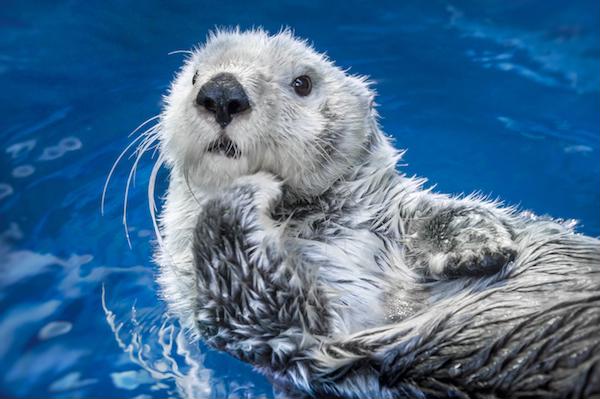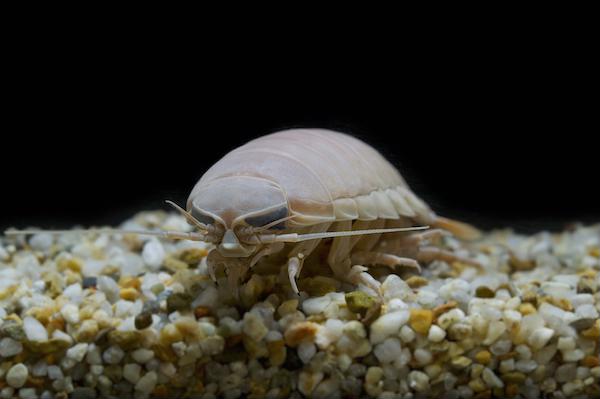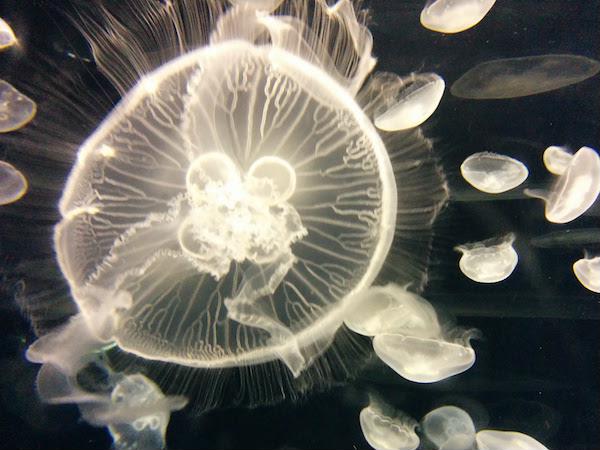This is an aquarium that has challenged the typical aquarium conventions.
There are many vibrant, tropical fish inside the tank and it is fun just watching them while all thoughts of time slip away.
Because the fish are swimming overhead, visitors can observe them swimming from below which is a sight rarely seen.
It is easy to spend a lot of time here watching them, but there are still many other sights to enjoy so let’s carry on ahead.
From Japan’s forests to the Great Barrier Reef
Next, take the elevator from the 3rd to the 8th floor and head to an area that has recreated the environment of Japan’s forests.
The Asian small-clawed otter is so cute!
This is the smallest of the Otter family, and its name comes from the fact that it has small claws attached to its paws.
Here you can also see the habitats of other cute animals, such as sea otters, earless seals and penguins,
as well as that of fish which live in the Great Barrier Reef and the Amazon, making it an area that is fun for both children and adults.
Visitors can also watch the animals at feeding time but it can get very crowded,
so if you want to watch them in a more relaxed atmosphere it might be best to avoid this area during those times.
A giant, Pacific themed tank
The aquarium’s main exhibit has become the exit route for visitors, slowly spiralling down between two large tanks.
In the middle of this exhibit is a “Pacific Ocean” aquarium with a depth of 9m, a maximum length of 34m and 5,400 tonnes of water.
This aquarium has recreated the magnificent sight of the Pacific Ocean, containing hammerhead sharks and rays,
as well as a whale shark that measures over 5m long.
The way they slowly swim around is truly elegant and an impressive sight to see.
There is one thing to keep in mind here, and that is where to view the Pacific Ocean aquarium.
On arrival at this exhibit, the immediate viewing spot becomes extremely crowded
but there are plenty of other viewing spots further down, so please do not worry.
Take a look and think how wonderful and big the aquarium is while heading down a little bit further to a place where you can watch in your own time.
The Seto Inland Sea and the Japan Deep, as well as fluffy jellyfish
After walking through the Pacific Ocean exhibit, there is an aquarium that replicates the Seto Inland Sea.
There are also areas dedicated to the Cook Strait with loggerhead sea turtles,
and the Japan Deep with Japanese spider crabs and Bathynomus doederleinii, a giant isopod endemic to Japan.
It is truly amazing that each aquarium recreates the environment of each sea,
and it is hard to imagine the pressure the aquarium must be under in regards to the tank dedicated to the Japan Deep.
There is also an area just ahead containing a jellyfish display.
This area skilfully uses the lighting and water flow to create a fantastical display of fluffy jellyfish drifting around in the water.
There is no doubt that everyone will want to take plenty of photos of this beautiful sight.
However, some areas will be closed due to refurbishment from September 2017 and all areas from November, with plans to re-open in March 2018.
Get up close! New Interactive Exhibit
When passing through the permanent exhibit, you will also see the new interactive exhibit.
This area is different as visitors can see the living creatures without a panel of glass in front of them.
This means that the earless seals can be seen swimming and resting as though they are right in front of your eyes,
as can the penguins as they walk around.
Also, you will definitely want to experience the Maldives Zone where you can actually touch sharks and rays.
Just hearing ‘sharks’ and ‘rays’ makes most people nervous.
Surely you would get stung or even bitten, like in Jaws?
Don’t worry, there are no such ferocious or poisonous species in this area.
Be extremely quiet when touching them and you can feel the rough skin of the shark and the slippery skin of the ray.
Of course, don’t forget to wash your hands both before and after.
Top tips on how to enter the aquarium with ease
Here are some things that you need to know before visiting the Osaka Aquarium Kaiyukan.
It gets extremely crowded during holidays and weekends, sometimes taking up to 30 minutes just to buy the entrance tickets.
But, if you buy an Osaka Kaiyu Ticket or an online ticket, entry will be a lot easier.
These are very easy to purchase, so please do!
Firstly, the Osaka Kaiyu Ticket is a ticket that combines a rail ticket with unlimited travel and the entrance ticket to the aquarium.
There are ten different types of tickets for the various railway companies, such as Osaka City Subway, Hanshin Electric Railway, Kintetsu, and Nankai.
Please purchase the ticket that matches the railway company you are using.
Follow the link below for more details.
The location where the tickets can be bought is different for each railway company, so please confirm where to buy them from.
As an example, the Osaka City Plan includes the subway and entrance ticket and costs 2,550 yen for over 16 year olds.
The cheapest price for a ride on the subway is 180 yen, making a round trip 360 yen.
The entrance ticket alone is 2,300 yen, so the cost of the Osaka City Plan is only 110 yen extra making this an excellent buy.
When you think of how much time might be wasted by waiting in line, this is definitely a ticket that should be purchased.
※ Sales after April 2018 are not yet fixed (Today’s date is September 11, 2017)
There is also an online ticket option, but this is only recommended for those who are proficient in Japanese as the site is in Japanese.
This is a spot that is recommended for both adults and children,
and if you get a re-entry stamp on your hand, you can enjoy the aquarium at your own leisure.
 JAPAN Travel Concierge
JAPAN Travel Concierge














